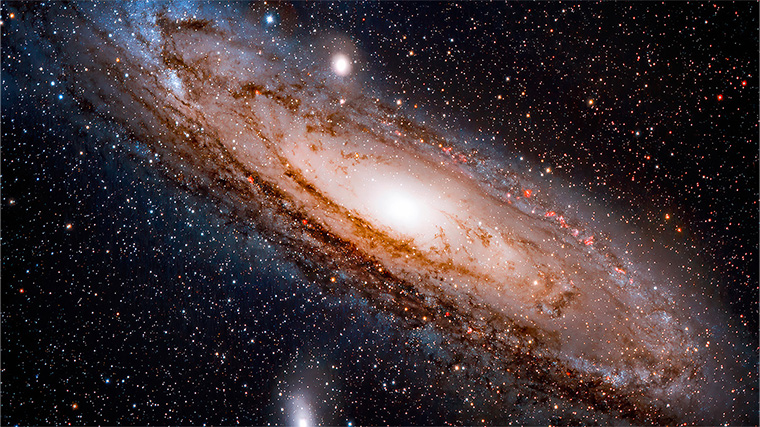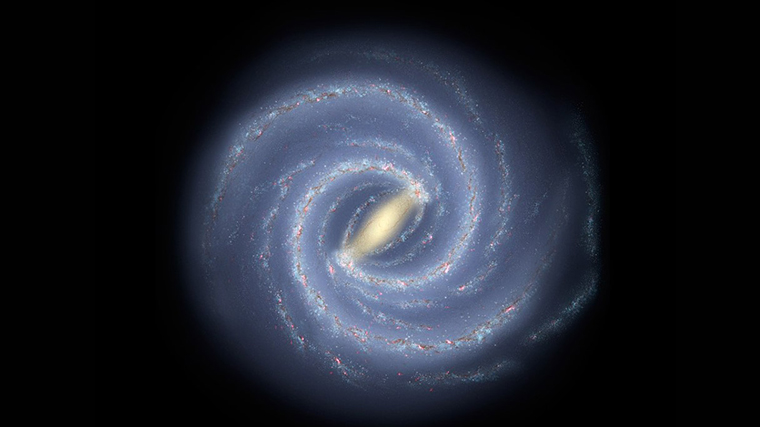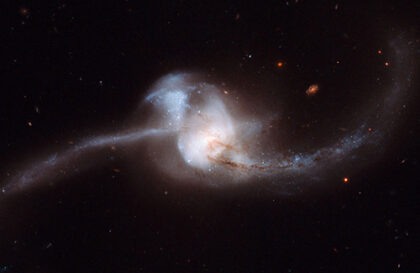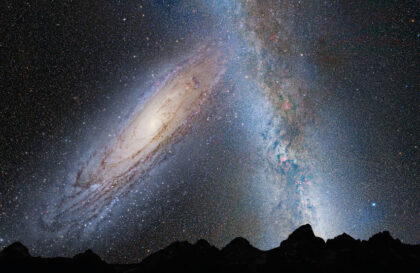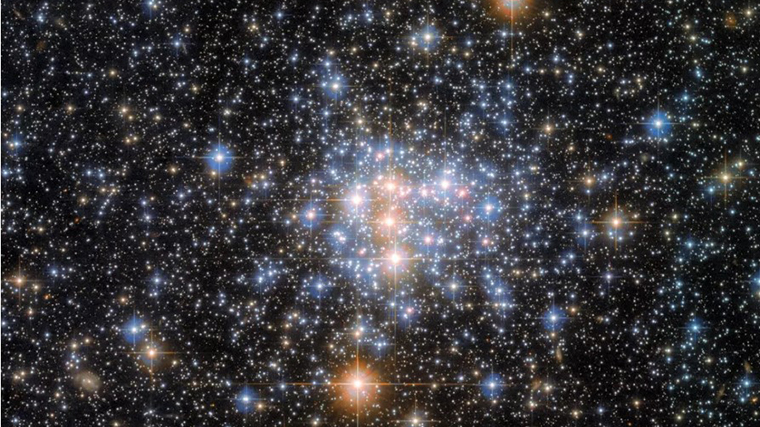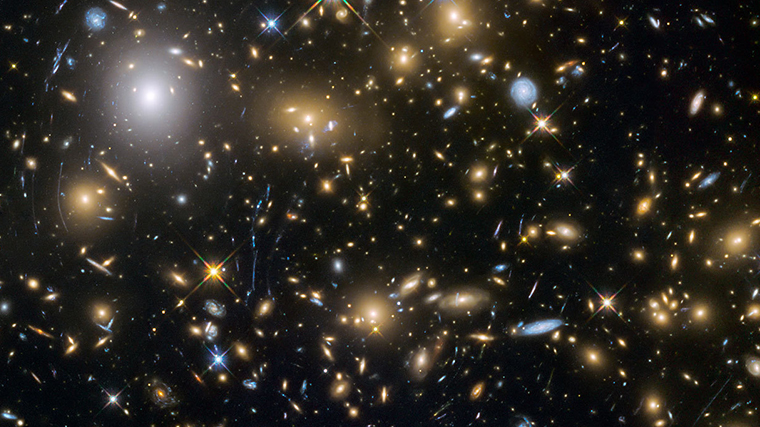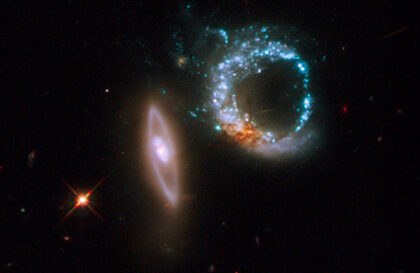Discovery and description
The first mention of the Andromeda galaxy appears in the “Catalogue of Fixed Stars” by the astronomer Al-Sufi from Persia (946), where he describes it as “a small cloud”. The first description of a galaxy based on telescopic observations was made by the German astronomer Simon Marius in 1612. Charles Messier, when creating his famous catalogue, erroneously attributed the discovery to Marius, writing the object as M 31. In 1785, William Herschel noted a faint red spot at the center of M 31 and, although he incorrectly estimated the distance to it, considered it to be the nearest nebula.
In 1864, William Huggins, studying the spectrum of M 31, revealed a difference from gas and dust nebulae, which indicated many stars. This was confirmed in subsequent years, prompting Huggins to suggest a stellar nature for the object.
In 1885, the galaxy experienced the supernova SN 1885A, known as S Andromedae. This is the only known event of its kind in M 31.
The first photographs of the galaxy were taken by Welsh astronomer Isaac Roberts in 1887. He was the first to identify the object’s spiral structure, but at the time M 31 was thought to belong to the Milky Way, and Roberts mistook it for another solar system with planets forming.
American astronomer Westo Slifer in 1912 determined the radial velocity of the Andromeda galaxy. Spectral analysis allowed him to calculate that M 31 was moving at an unusually high speed for that time – about 300 km / s.
The Andromeda Galaxy, like the Milky Way, is part of the Local Group and moves towards the Sun at a speed of 300 km / s, which leads to a purple shift, not a red shift. Determination of the direction of motion of the Sun in the Milky Way allowed astronomers to establish that the Andromeda Galaxy and our Galaxy are approaching each other at a speed of 100-140 km / s. As a result, a collision of these galactic systems is expected in 3-4 billion years. They will probably merge into one large galaxy.
According to models published in September 2014, in 4 billion years the Milky Way will be swallowed up by the Large and Small Magellanic Clouds, and in 5 billion years it will itself be swallowed up by the Andromeda Nebula.
Structure
The Andromeda Galaxy is the largest in the Local Group: based on data obtained using the Spitzer space telescope, astronomers have found that it includes about a trillion stars. It has several dwarf satellites: M 32, M 110, NGC 185, NGC 147 and possibly others. Its length is 260,000 light years, which is 2.6 times greater than that of the Milky Way.
Core
In the core of M 31, as in many other galaxies (including the Milky Way), there is a candidate for supermassive black holes. Calculations have shown that its mass exceeds 140 million solar masses.
In 2005, the Hubble Space Telescope discovered a mysterious disk of young blue stars surrounding a supermassive black hole. They revolve around a relativistic object, just like the planets around the sun. Astronomers have been puzzled by how such a donut-shaped disk could form so close to such a massive object. According to calculations, the monstrous tidal forces of a black hole should not allow gas and dust clouds to thicken and form new stars.
Using a spectrograph mounted on the Hubble telescope, observers have determined that the cluster consists of more than four hundred stars that formed approximately 200 million years ago. The stars are grouped into a disk only 1 light year in diameter. In the center of the disk, older and cooler red stars, previously discovered by Hubble, nest.
Due to the gravitational influence of the black hole, the cluster moves at a speed of 620 miles / s (1000 km / s). At this speed, you can fly around the globe in 40 seconds or get from the Earth to the Moon in 6 minutes.
Other objects in the galaxy
About 460 globular clusters have been registered in the galaxy. The most massive of them – Mayall II, also called G1 – has the highest luminosity in the Local Group, ahead of the brightness of the brightest cluster in the Milky Way – Omega Centauri. It is located at a distance of about 130,000 light-years from the center of the Andromeda galaxy and contains at least 300,000 old stars. Its structure, as well as stars belonging to different populations, indicate that this is most likely the core of an ancient dwarf galaxy, once swallowed by M31. According to research, at the center of this cluster is a candidate black hole with a mass of 20,000 suns. Similar objects also exist in other clusters.
A new kind of star clusters
In 2005, astronomers discovered an entirely new kind of star cluster in the halo of M 31. The three newly discovered clusters contain hundreds of thousands of bright stars. But what distinguishes them from globular clusters is that they are much larger—several hundred light-years across—and also that they are less massive. The distances between the stars in them are also much greater. Perhaps they represent a transitional class of systems between globular clusters and dwarf spheroidal galaxies.
First exoplanet
The galaxy hosts the star PA-99-N2, which is orbited by an exoplanet – the first to be discovered outside the Milky Way.
According to the results of studies published in June 2013, there are at least 35 black holes in the galaxy – much more than previously thought and than our galaxy has.
Satellite galaxies
The Andromeda Galaxy, like our Milky Way, is surrounded by several dwarf galaxies – small star systems consisting of several billion stars. The largest and most famous of them are the compact elliptical galaxies M 32 and M 110, visible in any photograph of the Andromeda Galaxy.
Calculations show that M 32 in the recent past may have been a spiral, but the process that supports the formation of its spiral arms was suppressed by the powerful tidal forces of the Andromeda Galaxy.
M 110 also participates in gravitational interaction with the Andromeda Galaxy: astronomers have discovered a giant stream of stars rich in heavy metals on the periphery of M 31 – in its halo. Similar stars also inhabit the dwarf M 110, which indicates their migration from one galaxy to another. Thus, they form a kind of star bridge.
In the course of many years of observations with the help of the Canada-France-Hawaii telescope, a whole group of dwarf galaxies circulating in the same plane around M 3 was discovered.
Credit рhoto:
